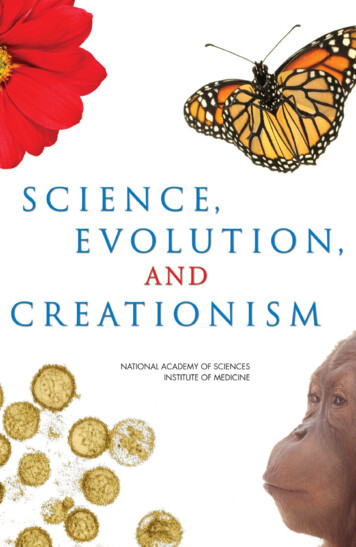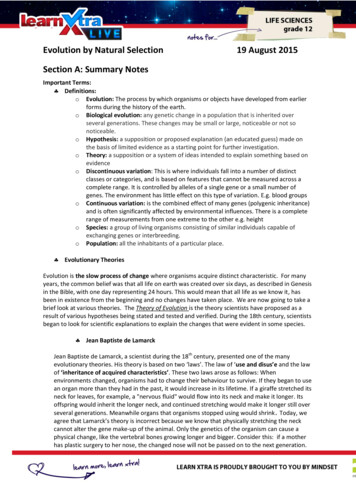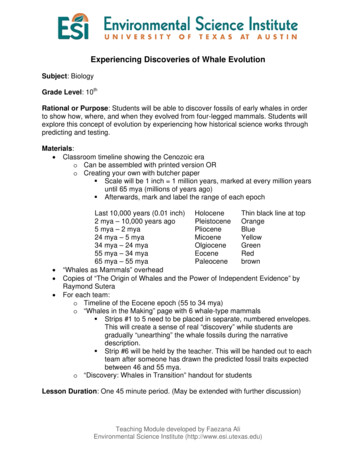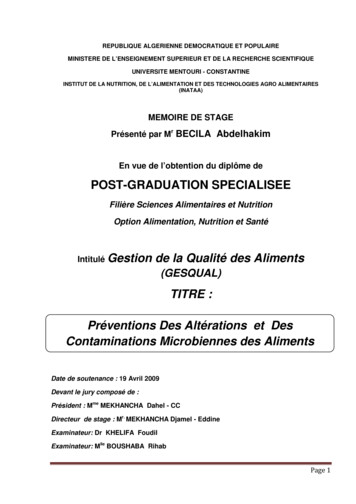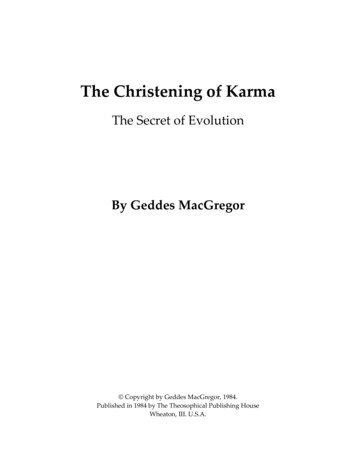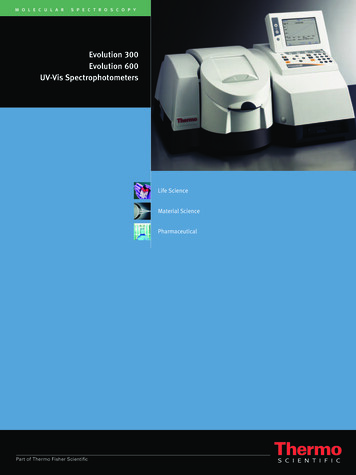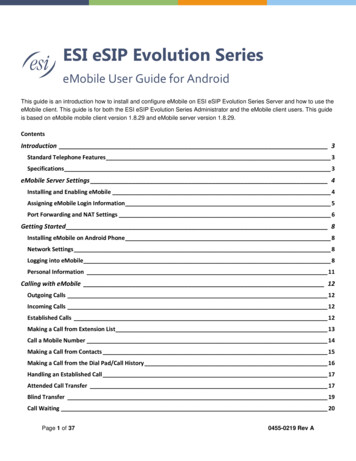
Transcription
Evidence of Evolution-Answers in grayBackgroundWhen Charles Darwin first proposed the idea that all new species descend from an ancestor, heperformed an exhaustive amount of research to provide as much evidence as possible. Today, themajor pieces of evidence for this theory can be broken down into the fossil record, embryology,comparative anatomy, and molecular biology.FossilsThis is a series of skulls and front leg fossils of organisms believed to be ancestors of the modernday horse.Source: http://www.iq.poquoson.org1.Give two similarities between each of the skulls that might lead to the conclusion that these are allrelated species.the pointy bone on top of the muzzle of the horse and the triangular shape of the head and the gapbetween front and rear teeth2.What is the biggest change in skull anatomy that occurred from the dawn horse to the modernhorse?Increase in the size of the skull; a shift from cusps to complex ridges on the grinding surface of thepremolars and molars, elongation of the face and of the space between the incisors and cheekteeth, an anterior shift of the cheek teeth so they lie forward of the eye; a deep lower jaw bone;3. What is the biggest change in leg anatomy that occurred from the dawn horse to the modernhorse?Fifty five million years ago, there was an animal the size of a small dog, called Hyracotherium(sometimes called Eohippus). Its front feet had four toes, and its back feet had three. Modern horsefeet have a single hoof. We see the reduction and loss of the side toes and enlargement of theterminal phalanx (hood) elongation and enlargement of the central metapodial (the longest bone inthe foot)EmbryologyOrganisms that are closely related may also have physical similarities before they are even born!Take a look at the six different embryos below:
Source: http://www.starlarvae.orgThese are older, more developed embryos from the same organisms.Hypothesizewhich embryo isfrom each of the following organisms:These are embryos at their most advanced stage, shortly before birth.Describe how the embryos changed for each of these organisms from their earliest to latest stages.SpeciesHumanAnatomical Changes From Early to Late StagesDeveloped limbs, defined features in face, neck, ears, loss of tail, tiny fingers present
Developed beak, tail shorter, wings and legs developed, head quite largeChickenTail gone, developed limbs, detailed features in ears and mouthRabbitShell developed, limbs have developed, tail is thinner, large belly, long tail, beakTortoiseSalamanderHas gills, tail and large underbellyFishfins developed, gills, tail and scales1.Look again at the six embryos in their earliest stages. Describe the patterns you see. Whatphysical similarities exist between each of the embryos?Same basic shape, circular spots (eyes) and underbelly, all have tails, tiny bumps on underside,hole for ear2. Does this suggest an evolutionary relationship? Explain how these embryos can be used asevidence of a common ancestor between each of these six organisms.Examination of vertebrate embryos reveals that during corresponding stages of early development,the embryos appear to be very similar. For example, all vertebrate embryos pass through stages inwhich they have gill pouches. The pouches eventually develop into the gill apparatus in fish; in laterevolving vertebrates that do not have gills, the gill pouches undergo further refinement and developinto structures associated with the head and neck. Similarly, all early vertebrate embryos have tails,which persist in some animals but regress during the later stages of development of humans. Thus,
the individual development of an animal occurs through a series of stages that paint a broad pictureof the evolutionary stages (phylogeny) of the species to which it belongs."Ontogeny recapitulates Phylogeny", HaeckelRead more: html#b#ixzz2stPBHWw9Comparative AnatomyShown below are images of the skeletal structure of the front limbs of 6 animals: human, crocodile,whale, cat, bird, and bat. Each animal has a similar set of bones. Color code each of the bonesaccording to this key:For each animal, indicate what type of movement each limb is responsible for.
Animal Primary FunctionsHuman Using tools, picking up and holding objectsWhale swimmingCat running, walking, jumpingBat flying, flapping wingsBird walking, hopping,Crocodile swimming, walking/crawlingComparison to Human Arm in FunctionAnimalComparison to human arm in formComparison to Human Arm in functionwhaleWhale has a much shorter andthicker humerus, radius, and ulna.Much longer metacarpals.Whale fin needs to be longer to help inmovement through water. Thumbs are notnecessary, as they don’t need to pick upand grasp things.catCurved humerus, shorter thinnerhumerus and ulna and radius,smaller metacarpals and phalangesMovement of cat involves jumping andrunning, smaller for agility and balancing onsmall ledges, no thumbs for grasping sincethey use claws and teeth for this.batThinner humerus, ulna, radius,smaller carpals, longer and thinnermetacarpals and phalangesBones are smaller so that there is lessweight in flight, long metacarpals andphalanges to extend wingsbirdSlightly shorter humerus, ulna,radius; metacarpals fused together,fewer but pointy phalangesBones are thinner for flight, moreaerodynamic and lightcrocodileShorter, thicker humerus, ulna andradius, larger carpals, pointyphalangesThicker legs to support heavy weight andlong metacarpals for swimmingCompare the anatomy of the butterfly and bird wing below.
1. What is the function of each of these structures?flying and gliding2. How are they different in form? Give specific differences.2 pieces of the wing in butterfly whereas amny feathers in a bird’s wing. There are bones in abird’s wing and non in the butterfly.Compare the overall body structure of the cave fish and the minnow below.1. What is the biggest, most obvious difference between the body structure of these two fish?Cave fish lack eyes and scales2. Assume the two fish came from the same original ancestor. Why might the cave fish haveevolved without eyesight?It’s in a dark environment all of the time and so no need for sight. This adaptation would nothave given it an advantage and therefore was not selected for.3. What kind of sensory adaptation would you hypothesize the cave fish has to allow it to navigate ina cave, including catching and eating food?Sensitivity to motion/vibration/electrical impulses/sound/smell/tasteYou have now studied three different types of anatomical structures:Homologous structures show individual variations on a common anatomical theme. These areseen in organisms that are closely related.1. Give an example of a homologous structure from this activity:Crocodile leg, human armHuman and cat front legsAnalogous structures have very different anatomies but similar functions. These are seen inorganisms that are not necessarily closely related, but live in similar environments and have similaradaptations.
2. Give an example of an analogous structure from this activity:Butterfly and bird wing or bat wingVestigial structuresare anatomical remnants that were important in the organism’s ancestors, but are no longerused in the same way.3. Give an example of a vestigial structure from this activity:Thumb of a whale fin4. Below are some vestigial structures found in humans. For each, hypothesize what its functionmay have been.StructurePossible functionWisdom teethExtra grinding ability for vegetationAppendixStore “good” bacteria to fight infections ordigest cellulose like the caecum in rabbitsMuscles for moving the earBetter hearing by changing direction of earsBody hairKeeping warmStop pathogens from getting to mucousmembranesTrap pheromones/oil on bodyLittle toeBalance/clinging on rocks/treesTailboneRear stabilizing limb, balance5. How are vestigial structures an example of evidence of evolution?Vestigial organs are often homologous to organs that are useful in other species. Thevestigial tailbone in humans is homologous to the functional tail of other primates. Thusvestigial structures can be viewed as evidence for evolution: organisms having vestigialstructures probably share a common ancestry with organisms in with organisms in which thehomologous structure is functional.Molecular BiologyCytochrome c is a protein found in mitochondria. It is used in the study of evolutionary relationshipsbecause most animals have this protein. Cytochrome c is made of 104 amino acids joinedtogether. Below is a list of the amino acids in part of a cytochrome protein molecule for 9 differentanimals. Any sequences exactly the same for all animals have been skipped.For each non-human animal, take a highlighter and mark any amino acids that are different than thehuman sequence. When you finish, record how many differences you found in the table on the nextpage.
AnimalNumber of AminoAcid DifferencesCompared toHumanCytochrome CAnimalNumber of AminoAcid DifferencesCompared toHumanCytochrome bit4Molecular Biology – Summary Questions1. Based on the Cytochrome C data, which organism is most closely related to humans?Monkey2.Do any of the organisms have the same number of differences from human Cytochrome C? Insituations like this, how would you decide which is more closely related to humans?None of the organisms have the same number of difference from the human Cytochrome C. Insituations like this, we can decide which is more closely related to humans by comparing anatomystructures, evolutionary tree or comparing them to the human genes by using another protein.Conclusion1.Charles Darwin published his book On the Origin of Species in 1859. Of the different types ofevidence that you have examined, which do you think he relied upon the most, and why?Darwin relied on the similar anatomies of species to link them. He also had some fossil evidencethat showed slight changes in the body structure of the species over time, often leading to vestigialstructures.2. Given the amount of research and evidence available on evolution, why is it classified as atheory?The scientific definition of the word "theory" is different from the colloquial sense of the word.Colloquially, or in everyday language, "theory" can mean a hypothesis, a conjecture, an opinion, ora speculation that does not have to be based on facts or make testable predictions. However, inscience, the meaning of theory is more rigorous. A theory is a hypothesis corroborated byobservation of facts, which makes testable predictions. In science, a current theory is a theory thathas no equally acceptable or more acceptable alternative theory.
Evidence of Evolution-Answers in gray Background When Charles Darwin first proposed the idea that all new species descend from an ancestor, he performed an exhaustive amount of research to provide as much evidence as possible. Today, the major pieces of evidence for this theory can be broken down into the fossil record, embryology,



